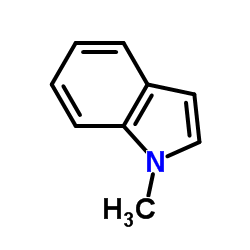1-Methylindole

1-Methylindole structure
|
Common Name | 1-Methylindole | ||
|---|---|---|---|---|
| CAS Number | 603-76-9 | Molecular Weight | 131.17 | |
| Density | 1.0±0.1 g/cm3 | Boiling Point | 239.4±9.0 °C at 760 mmHg | |
| Molecular Formula | C9H9N | Melting Point | 94 - 95ºC | |
| MSDS | Chinese USA | Flash Point | 98.6±18.7 °C | |
|
Natural compounds boldine and menthol are antagonists of human 5-HT3 receptors: implications for treating gastrointestinal disorders.
Neurogastroenterol. Motil. 26(6) , 810-20, (2014) Impaired 5-HT3 receptor function is likely involved in the pathogenesis of functional gastrointestinal disorders (FGID) and 5-HT3 receptor antagonists are effective treatments for chemotherapy-induced nausea and vomiting (CINV) and irritable bowel syndrome (I... |
|
|
Degradation of substituted indoles by an indole-degrading methanogenic consortium.
Appl. Environ. Microbiol. 57(9) , 2622-7, (1991) Degradation of indole by an indole-degrading methanogenic consortium enriched from sewage sludge proceeded through a two-step hydroxylation pathway yielding oxindole and isatin. The ability of this consortium to hydroxylate and subsequently degrade substitute... |
|
|
Single-fluorophore-based fluorescent probes enable dual-channel detection of Ag⁺ and Hg²⁺ with high selectivity and sensitivity.
Anal. Chim. Acta 839 , 74-82, (2014) A new type of fluorescent probe capable of detecting Ag(+) and Hg(2+) in two independent channels was developed in the present work. Specifically, in CH3CN-MOPS mixed solvents with CH3CN/MOPS ratio (v/v) of 15/85, this type of probe fluoresced weakly, and the... |
|
|
Photodissociation dynamics of N-methylindole, N-methylpyrrole, and anisole.
J. Phys. Chem. A 113(16) , 3881-5, (2009) Photodissociation experiments employing molecular beams of N-methylindole, N-methylpyrrole, and anisole at 193 and 248 nm, respectively, have been conducted using multimass ion imaging techniques. We find that CH3 elimination is the sole dissociation channel ... |
|
|
Spectroscopic characterization studies of 1-methyl indole with benzene derivatives.
Spectrochim. Acta. A. Mol. Biomol. Spectrosc. 77(1) , 179-83, (2010) The NMR and fluorescence quenching of benzene, chlorobenzene and methoxybenzene in acetonitril and 2-propanol solvents have been carried out with a view to understand the quenching mechanisms. The quenching is found to be appreciable and shows positive deriva... |
|
|
Association constants for the electron-donor-acceptor complexes of indole and 1-methylindole with 1-(2, 4, 6-trinitrophenyl) propan-2-one from nuclear magnetic resonance shift measurements. An anomalous scatchard plot. Chudek JA, et al.
J. Chem. Soc., Faraday 84(4) , 1145-52, (1988)
|
|
|
Au(III)/TPPMS-catalyzed benzylation of indoles with benzylic alcohols in water.
J. Org. Chem. 78(23) , 12128-35, (2013) A novel and efficient method for the Au(III)/TPPMS-catalyzed direct substitution reaction of benzhydryl and benzylic alcohols with indoles in water is developed. Au(III)/TPPMS is an effective catalyst for the benzylation of the strong π nucleophile 1-methylin... |
|
|
Concise assembly of the polycyclic frameworks associated with the hapalindole and fischerindole alkaloids.
Org. Lett. 8(21) , 4959-61, (2006) [reaction: see text] Reaction of N-methylindole (4) with 6,6-dibromobicyclo[3.1.0]hexane (5) in the presence of silver tetrafluoroborate affords conjugate 7 in 67% yield. This product can be readily elaborated to compounds 12b and 13b which embody the polycyc... |
|
|
Direct palladium-catalyzed C-2 and C-3 arylation of indoles: a mechanistic rationale for regioselectivity.
J. Am. Chem. Soc. 127(22) , 8050-7, (2005) We have recently developed palladium-catalyzed methods for direct arylation of indoles (and other azoles) wherein high C-2 selectivity was observed for both free (NH)-indole and (NR)-indole. To provide a rationale for the observed selectivity ("nonelectrophil... |
|
|
Room temperature palladium-catalyzed 2-arylation of indoles.
J. Am. Chem. Soc. 128(15) , 4972-3, (2006) This communication describes the rational development of a PdII-catalyzed method for the direct 2-arylation of indoles using [Ar-IIII-Ar]BF4. These reactions proceed under remarkably mild conditions (often at room temperature and in the presence of ambient ai... |